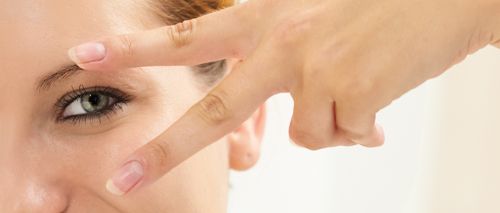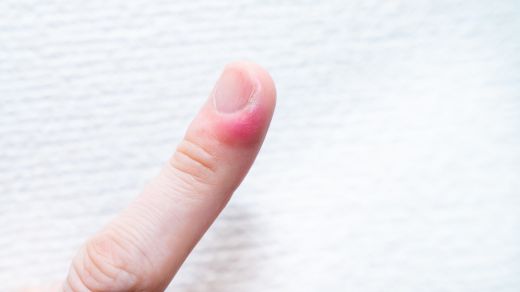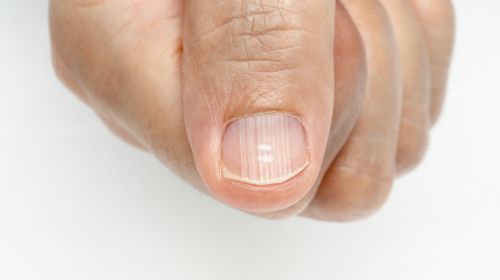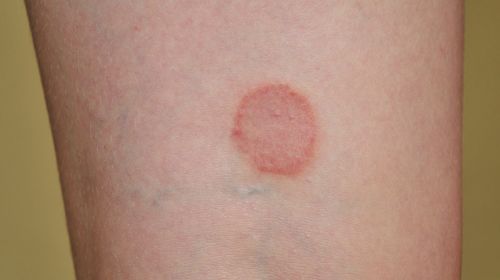Nail bed inflammation is usually accompanied by throbbing pain as well as redness and sensitivity to touch. Inflammation of the nail bed on the finger or toe is triggered by bacteria that penetrate small injuries in the skin. What to do if you have nail bed inflammation and which home remedies help!
- © Getty Images/shirosuna-m
Quick overview: nail bed inflammation
Definition: In the case of nail bed inflammation (onychia), the nail bed, i.e. the area below a toenail or fingernail, is inflamed. If the surrounding area is affected, such as the nail wall, nail fold or cuticle, it is called paronychia.
Causes: The main causes are staphylococci (bacteria), and more rarely fungi or viruses.
Symptoms: Signs include throbbing pain, warmth and redness. Pus formation under the skin is also possible.
What to do if you have nail bed inflammation? Hand or foot baths with chamomile, salt or soap are common home remedies. If home remedies don’t help, antibiotics or medications against viruses and fungi can be considered. In addition, possible pus accumulations can be removed surgically.
Course: Inflammation of the nail bed usually heals within three days with the help of home remedies. However, sometimes further treatment is required. If left untreated, the inflammation can spread and, in the worst case, it can lead to bone damage or blood poisoning.
At a glance:
Nail bed inflammation: what is it?
In addition to nail fungus, nail bed inflammation is one of the most common diseases of finger and toenails.
Inflammation of the nail bed – below a fingernail or toenail – is usually caused by an infection with staphylococci, which are part of the normal microbiome of the skin. However, if they get into the nail bed through small to tiny skin injuries, which occur during nail care, for example, they can trigger nail bed inflammation (onychia).
Once the pathogens have penetrated the skin through a wound, they often no longer just infect the nail bed, but also the surrounding area:
- the cuticle
- the nail wall (lateral boundary of the nail)
- the nail fold (lower nail boundary)
Experts then speak of paronychia. If the nail bed infection moves deeper, an accumulation of pus, a so-called panaritium, can arise, which in the worst case leads to blood poisoning (sepsis).
Nail bed inflammation: symptoms – small infection, big pain
The main symptoms of nail bed inflammation are:
- severe skin redness,
- swelling as well
- throbbing pain.
In some cases, those affected report feeling their pulse in their inflamed finger or toe. These areas hurt particularly when pressure is applied to them. Overheating also characterizes acute inflammation of the nail bed.
If the inflammation of the nail bed has already become chronic, it causes fewer symptoms. The nail wall and nail fold, i.e. the lower and side edges of the nail, can turn reddish, purple or blue.
Causes and risk factors: How does inflammation of the nail bed occur?
Bacteria, more specifically staphylococci, are usually to blame for painful nail bed inflammation. For example, they get under the skin through small cuts or abrasions while doing housework or gardening. Multi-resistant strains of this type of bacteria pose a particularly high risk Staphylococcus aureus (MRSA), a so-called hospital germ. Inflammation of the nail bed can also result in dangerous blood poisoning.
In addition, herpes viruses and yeast fungi, such as Candida albicans or Candida glabrata, also cause inflammation of the nail bed. In chronic nail bed inflammation, several nails are often infected at the same time.
Risk factors include previous illnesses and incorrect nail care
Inflammation of the nail bed is often caused by rough nail care. For example, injuries caused by sharp scissors, cutting or roughly pushing back the cuticles and biting nails are risky.
People with diabetes mellitus or neurodermatitis are also more susceptible. Poor circulation or dry skin due to aggressive, frequent hand washing also increase the risk of developing nail bed inflammation.
Certain professional groups such as
- hairdressers
- Bakers
- Cleaners
have to struggle more often with nail bed inflammation because they work with aggressive chemicals (dry out the skin) or flour (forms the nutritional basis for yeast fungi).
Therapy: Get rid of nail bed inflammation quickly
Nail bed infections can initially be treated well at home. Suitable as home remedies
- chamomile baths,
- Hand or foot baths with curd soap or
- warm water with table salt.
Soak the finger or toe affected by the inflammation in it for 20 minutes several times a day and then dry it carefully but gently and disinfect it with a spray or something similar from the pharmacy. Any further irritation of the infected area should be avoided. A plaster can protect the nail.
-

Another nail broken, torn or splintered!? This will help you get your nails strong and elastic again
read more!
In addition, non-prescription ointments from the pharmacy that have an antiseptic and anti-local inflammation effect can help. Possible options include pulling ointments with ammonium bituminosulfonate or iodine preparations.
Nail bed inflammation usually goes away within a few days with such treatment.
If the nail bed inflammation progresses, medical help is advisable
If home remedies or antiseptic ointments do not keep the inflammation at bay, pus can accumulate, which is yellowish and visible under the skin. At this point at the latest, a visit to the dermatologist or family doctor’s practice makes sense.
People with diabetes have particularly sensitive skin on their feet and should seek medical help immediately so that the nail bed inflammation does not spread. This also applies to patients with weakened immune systems – for example as a result of an HIV infection or chemotherapy for cancer.
Treatment depends on the pathogen and how far the inflammation has progressed. Often a prescription of an antibiotic or antifungal (antimycotic), for example in the form of an ointment, is sufficient.
In serious cases, the medication must also be swallowed as a tablet. If herpes viruses are to blame for nail bed inflammation, creams with antivirals as active ingredients can help.
If there is a large accumulation of pus, it may also be necessary to drain it through a small incision in the skin.
Caution, danger to life: Never empty the pus yourself
The following applies to the treatment of nail bed inflammation: Never remove the offending skin yourself or cut open pus blisters. This can cause the nail bed inflammation pathogens to penetrate deeper into the tissue and, in the worst case, cause sepsis, which can be fatal.
Course: Prevent nail bed inflammation from spreading
Normally, acute inflammation of the nail bed disappears within about three days. To do this, the fingernail or toenail in question should be protected and treated reliably with the appropriate measures. If the nail bed inflammation does not go away despite everything, but continues to spread, a very painful panaritium with accumulations of pus can form.
In addition to the local complaints, fever, chills and other general signs of illness can also occur. In addition, panaritium limits the mobility of the respective finger or toe due to severe swelling and severe pain.
Panaritium always requires medical treatment. Otherwise, in the worst case scenario, fatal sepsis can occur. In addition, the inflammation can spread to other tissue such as tendons and bones and cause damage.
If chronic nail bed inflammation remains untreated, the nail affected by the infection may become deformed. It can fall off the nail bed as it progresses.
These measures protect against nail bed inflammation
There are a number of measures to prevent nail bed inflammation. This includes, for example, proper nail care: If mistakes are made when cutting the nails, germs can easily penetrate the protected area under the nail, the nail bed.
Tips for manicure and pedicure:
- Only gently push back the cuticles with a special stick; never cut them off with sharp scissors.
- To prevent ingrown toenails: Unlike fingernails, always cut the toenail straight.
Appropriate footwear can prevent pressure points and injuries in the toe area.
Gloves can protect against nail bed infections
People who work with chemicals at work, such as nursing staff, doctors or florists, should wear gloves to protect nails and hands from the influence of the substances and to prevent nail bed infections.
Anyone who has dry skin is more prone to nail bed inflammation. In this case, care for your hands with rich, moisturizing creams that contain, for example, a high proportion of urea.


